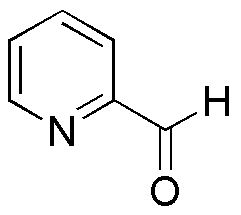2-Pyridinecarboxaldehyde is widely utilized in research focused on:
- Synthesis of Heterocyclic Compounds: This compound serves as a key building block in the synthesis of various heterocyclic compounds, which are essential in pharmaceuticals and agrochemicals.
- Ligand Development: It is used to develop ligands for coordination chemistry, enhancing the efficiency of catalysts in organic reactions, particularly in the production of fine chemicals.
- Flavors and Fragrances: The compound finds applications in the flavor and fragrance industry, contributing to the formulation of unique scents and tastes in consumer products.
- Analytical Chemistry: It is utilized in analytical methods for detecting and quantifying metal ions, making it valuable in environmental monitoring and quality control in various industries.
- Biological Research: Researchers leverage its properties to study biological pathways and mechanisms, particularly in drug development, where it can influence the activity of certain enzymes.
General Information
Properties
Safety and Regulations
Applications
2-Pyridinecarboxaldehyde is widely utilized in research focused on:
- Synthesis of Heterocyclic Compounds: This compound serves as a key building block in the synthesis of various heterocyclic compounds, which are essential in pharmaceuticals and agrochemicals.
- Ligand Development: It is used to develop ligands for coordination chemistry, enhancing the efficiency of catalysts in organic reactions, particularly in the production of fine chemicals.
- Flavors and Fragrances: The compound finds applications in the flavor and fragrance industry, contributing to the formulation of unique scents and tastes in consumer products.
- Analytical Chemistry: It is utilized in analytical methods for detecting and quantifying metal ions, making it valuable in environmental monitoring and quality control in various industries.
- Biological Research: Researchers leverage its properties to study biological pathways and mechanisms, particularly in drug development, where it can influence the activity of certain enzymes.
Documents
Safety Data Sheets (SDS)
The SDS provides comprehensive safety information on handling, storage, and disposal of the product.
Product Specification (PS)
The PS provides a comprehensive breakdown of the product’s properties, including chemical composition, physical state, purity, and storage requirements. It also details acceptable quality ranges and the product's intended applications.
Certificates of Analysis (COA)
Search for Certificates of Analysis (COA) by entering the products Lot Number. Lot and Batch Numbers can be found on a product’s label following the words ‘Lot’ or ‘Batch’.
*Catalog Number
*Lot Number
Certificates Of Origin (COO)
This COO confirms the country where the product was manufactured, and also details the materials and components used in it and whether it is derived from natural, synthetic, or other specific sources. This certificate may be required for customs, trade, and regulatory compliance.
*Catalog Number
*Lot Number
Safety Data Sheets (SDS)
The SDS provides comprehensive safety information on handling, storage, and disposal of the product.
DownloadProduct Specification (PS)
The PS provides a comprehensive breakdown of the product’s properties, including chemical composition, physical state, purity, and storage requirements. It also details acceptable quality ranges and the product's intended applications.
DownloadCertificates of Analysis (COA)
Search for Certificates of Analysis (COA) by entering the products Lot Number. Lot and Batch Numbers can be found on a product’s label following the words ‘Lot’ or ‘Batch’.
*Catalog Number
*Lot Number
Certificates Of Origin (COO)
This COO confirms the country where the product was manufactured, and also details the materials and components used in it and whether it is derived from natural, synthetic, or other specific sources. This certificate may be required for customs, trade, and regulatory compliance.


